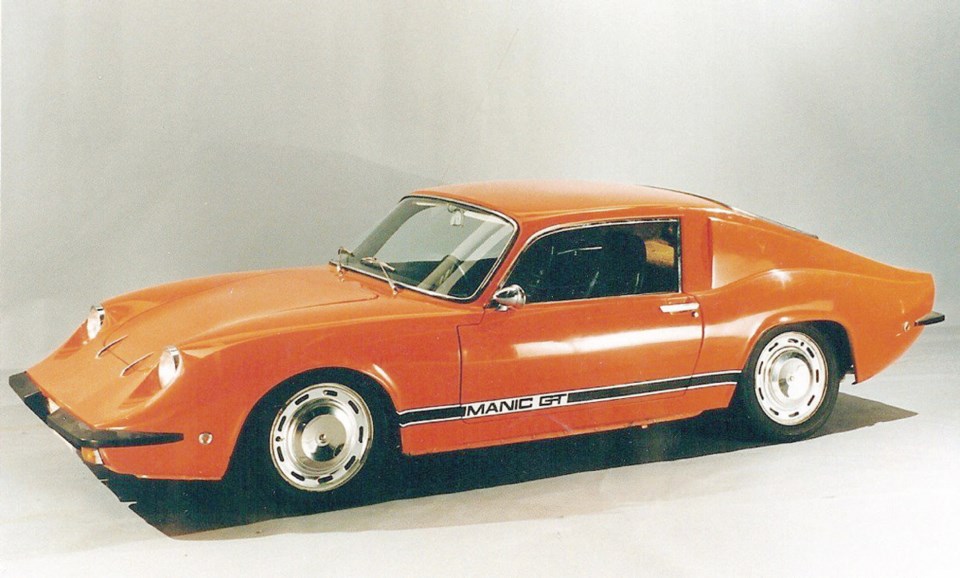Of the many millions of automobiles built in Canada, most were produced by subsidiaries of big established foreign manufacturers, everyone from General Motors to Volvo. Others were American designs made by Canadian companies, à la Gray Dort. There was one good example of an all-Canadian car, however: the Russell, produced in Toronto from 1905 to 1915.
In the more modern era, there was another brave Canadian attempt. It was called the Manic GT (named after Quebec’s Manicuagan River) and it was built in Quebec in 1970 and 1971, the brainchild of a young Montrealer named Jacques About.
In the late 1960s, About was a public relations officer with Renault Canada when Renault asked him to study the feasibility of importing the sporty Renault Alpine into Canada.
The Alpine was a specialized sports/competition car based on Renault components and made by an independent company (it would be absorbed by Renault in 1974). Alpines were sold through Renault dealers in Europe, where the car was well known.
Although About’s survey results were positive, Renault chose not to import the Alpine. But the idea of selling a sporty car was not dead as far as About was concerned. Very encouraged by the survey that revealed a market for such a car, he decided to leave Renault and produce his own sports car to fill the speciality niche the survey identified.
After building a version of the French GRAC racing car called the Manic GRAC under licence, a venture that garnered some good publicity, About established Les Automobiles Manic Inc. in 1968. He bought a 60,000-square-foot factory in Granby and began his mission to build the Manic GT two-seater sports coupe.
The enthusiastic and persuasive Mr. About proved so adept at fundraising that he attracted the backing of such heavyweights as Bombardier (snowmobiles), Steinberg (groceries) and the governments of Canada and Quebec. He soon raised capitalization of $1.5 million.
Design and production planning for the new car began in Granby. While the GRAC had been a racing car, the Manic GT was not intended for competition. It was to be a small, stylish, affordable two-passenger touring car offering good performance and low fuel consumption.
Being familiar with Renault components and the Renault company paved the way for About to make a deal to use the platform and running gear of the rear-engined Renault 10 sedan as the base for the Manic. It had good mechanical credentials: four-wheel independent suspension via coil springs, rack-and-pinion steering and four-wheel disc brakes.
The Renault engine was a sturdy, 1,289 cc, overhead-valve four-cylinder with five main bearings. It came in three stages of tune: 65, 80 and 105 horsepower and power reached the rear wheels through a standard four-speed manual transmission or optional five-speed.
The Manic emerged as a small car with a wheelbase of 2,280 millimetres, length of 4,127 mm and height of just 1,143 mm. Its sleek silhouette made it one of the lowest production cars.
The Manic weighed a feathery 658 kg, and this light weight combined and good aerodynamics paid off in performance and economy. A company brochure claimed that top speeds were 170, 190 and 220 kilometres per hour respectively for the three engines.
If the 220 figure was correct, it would have been one of the faster cars of its era. Fuel economy was claimed to be from 8.1 to 6.7 L/100 km. The fibreglass coupe’s styling was typical of contemporary small two-seaters. The front end was shovel-nosed in appearance and the rear engine meant no grille was necessary. The appearance of the Manic GT was not unlike some kit cars then on the market, a suggestion that would no doubt have mortified About.
The company introduced the Manic GT at the 1969 Montreal Auto Show with a $3,400 price tag, the same neighbourhood as the Ford Mustang and Chevrolet Camaro. This put it up against some stiff competition.
Unfortunately, a component supply problem soon developed. According to Perry Zavitz’s book Canadian Cars, 1946-1984, Renault’s supply of parts to Manic was unreliable and slow. To keep production going, Manic even resorted to scrounging parts from Renault dealers.
It was all too much for the young enterprise, and in spite of reportedly having a solid order book, it could not continue. The Granby plant closed in May 1971 after producing only 160 Manic GTs, far below the planned first-year output of 1,300.
Another valiant attempt to start and operate a successful Canadian car company had failed. Fortunately, some Manic GTs have been preserved, including one in the National Museum of Science and Technology in Ottawa.
